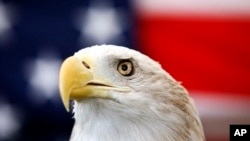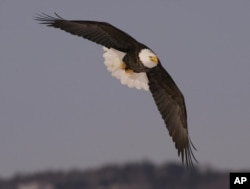And now, Words and Their Stories, from VOA Learning English.
From above, birds must have a wonderful view of the world below. Flying over everything at such a height gives them a rare ability to see many things.
In English, we use the term “bird’s eye view” to describe a view from above as if seen by a bird in flight. It is also described as an “overall view” or “big picture view.”
For example, when I start a project, I first like to get a bird’s eye view. I ask myself several important questions: What is the overall goal? Who is the main focus? What resources do I have available to me? Answers to these “big picture” questions can help me understand the scope of the project.
Now, let's talk about noticing the smaller details.
The Raptor Center is part of the University of Minnesota’s College of Veterinary Medicine. Its website explains why eagles, hawks, and owls see so well: “Raptors have powerful binocular vision, where both their left and right eyes can see and focus on a single object.”
Eagles and hawks also have a special bone structure around their eyes that protects them from bright sunlight. Their ability to focus on faraway details in addition to other factors make them extremely effective hunters.
In English, the keen vision of eagles and hawks describes a certain type of person.
If you have an eagle eye, you have the ability to see or notice distant objects. Also, you observe everything, even very small details which others might miss. On the same note, someone who is hawk-eyed watches and notices everything that happens.
These types of people may even perceive things that are not clear to others. Both eagle-eyed and hawk-eyed people are observant or perceptive.
A person does not have to have this ability all the time. They might use their keen vision and powers of observation only at certain times, especially times when they need to keep a close watch.
For example, during Christmastime, hawk-eyed children might search the sky looking for Santa Claus. These children may not be very observant during the rest of the year, but during Christmastime, they are looking for gifts.
Let’s hear these terms used between two friends.
A: This is a great party. Thanks for inviting me.
B: The more the merrier! This yearly neighborhood party always draws a huge number of people.
A: I’d say so! There must be over a hundred people here! Hey, wait a minute. I think I see our old co-worker. Isn’t that Samantha way over there by the food and drinks?
B: I don’t know. I can’t see that far.
A: It’s her. My eagle eyes don’t miss a thing. I’m going to go say hi and grab the last hamburger while I’m there. Oh, and you should let the hosts know that they’re low on drinks.
B: Wow! You’re right. I didn’t realize you were so hawk-eyed.
A: Only at parties. I start off with a bird’s eye view and then focus in on the food, drinks, and people I want to see more closely. See you in a few…
The term “eagle eye” has been used for hundreds of years. Word experts say it was first used in writing in the mid-1500s. The Oxford English Dictionary website says the “earliest evidence for ‘eagle eye’ is from 1567, in the writing of Thomas Stapleton, a Roman Catholic theologian.”
A theologian is an expert in religious thought.
And that’s all the time we have for this Words and Their Stories. Until next time, I’m Anna Matteo.
Anna Matteo wrote this story for VOA Learning English.
___________________________________________________
Words in This Story
view –n. things that can be seen from a certain position or place
focus –n. the thing that takes up most of one’s attention : focus –v. to make an image seen by the eyes as sharp as possible
notice –v. to see and pay attention to something
prey –n. an animal that is being hunted
binocular –adj. involving two eyes
factor –n. one thing that is involved in a process aimed at producing a result
keen –adj. very sharp
perceive –v. to understand












Forum